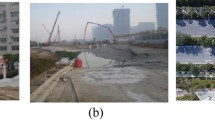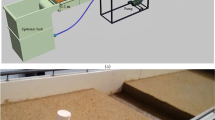Abstract
Water–sand mixture inrushes into shallow underground workings have caused casualties and property loss. A coupled fluid–solid analog model was developed to simulate the water–sand mixture inrush processes during mining from fracture production and development, based on the hydrogeological conditions at the #22304 working face of the Shigetai coal mine in the Erdos coal basin of northeast China. The deformation characteristics of the overlying strata and water pressure variations within the water-flowing fractured zone were monitored and analyzed. The results show that the water–sand mixture inrush consists of three stages: development of cracks in the overlying strata, initiation of a water inrush channel, and evolution of the inrush channel. The stresses of the overlying strata, water pressures, and permeability characteristics of water and sand inrush pathways change within the three stages. These findings lay a solid foundation for predicting water–sand mixture inrushes in shallow coal mines.
抽象的
浅埋煤层工作面的水沙突溃已造成人员伤亡和财产损失。依据中国东北鄂尔多斯聚煤盆地石圪台煤矿#22304工作面的水文地质条件, 建立了流-固耦合模拟模型, 模拟开采期间裂隙产生和扩展而诱发水沙混合物突溃的过程。监测和分析了上覆地层的变形特征和导水裂隙带的水压变化。结果表明, 水沙混合物的突溃包括三个阶段: 上覆地层裂缝发展、突水通道生成和突水通道演化。上覆地层应力、水压和水沙突出通道渗透性随三个阶段而变化。研究为预测浅埋煤层水沙混合突溃奠定了坚实基础。
Resumen
Las irrupciones de mezclas de agua y arena en las explotaciones subterráneas poco profundas han causado víctimas y pérdidas materiales. Se ha desarrollado un modelo analógico con acoplamiento fluido-sólido para simular los procesos de irrupción de la mezcla de agua y arena durante la explotación minera a partir de la producción y el desarrollo de fracturas, basándose en las condiciones hidrogeológicas del frente de trabajo #22304 de la mina de carbón de Shigetai en la cuenca de carbón de Erdos, en el noreste de China. Se monitorizaron y analizaron las características de deformación de los estratos suprayacentes y las variaciones de la presión del agua dentro de la zona fracturada por el flujo de agua. Los resultados muestran que la irrupción de la mezcla de agua y arena consta de tres etapas: desarrollo de grietas en los estratos suprayacentes, inicio de un canal de irrupción de agua y evolución del canal de irrupción. Las tensiones de los estratos suprayacentes, las presiones del agua y las características de permeabilidad de los canales de irrupción de agua y arena cambian dentro de las tres etapas. Estos resultados sientan una base sólida para predecir las irrupciones de mezclas de agua y arena en minas de carbón poco profundas.





Similar content being viewed by others
References
Chen L, Feng X, Xie W, Wen Z, Zheng Z (2016) Using a fluid–solid coupled numerical simulation to determine a suitable size for barrier pillars when mining shallow coal seams beneath an unconsolidated, confined aquifer. Mine Water Environ 36(1):1–11. https://doi.org/10.1007/s10230-016-0404-6
Huang Q, He Y, Cao J (2019) Experimental investigation on crack development characteristics in shallow coal seam mining in China. Energies. https://doi.org/10.3390/en12071302
Jin Z, Peng T (2021) Control of the internal and external staggered distance of coal mining face to the water-conducting fissures in the overlying strata of the near coal. Adv Civ Eng. https://doi.org/10.1155/2021/1499675
LaMoreaux JW, Wu Q, Zhou W (2014) New development in theory and practice in mine water control in China. Carbonate Evaporite 29:141–145. https://doi.org/10.1007/s13146-014-0204-7
Li J, Liu C (2017) Formation mechanism and reduction technology of mining-induced fissures in shallow thick coal seam mining. Shock Vib 2017(pt 3):1–14. https://doi.org/10.1155/2017/1980817
Sui W, Dong QH (2008) Variation of pore water pressure and its precursor significance for quicksand disasters due to mining near unconsolidated formations. Chin J Rock Mech Eng 27(9):1908–1916. https://doi.org/10.1016/S1872-5791(08)60057-3 ((in Chinese))
Sui W, Cai GT, Dong QH (2007) Experimental research on critical percolation gradient of quicksand across overburden fissures due to coal mining near unconsolidated soil layers. Chin J Rock Mech Eng 26(10):2084–2091. https://doi.org/10.1016/S1872-2067(07)60020-5(inChinese)
Sui W, Hang Y, Ma L et al (2015) Interactions of overburden failure zones due to multiple-seam mining using longwall caving. B Eng Geol Environ 74(3):1019–1035. https://doi.org/10.1007/s10064-014-0674-9
Wang SD, Shen XH, Mou P (2009) Perdition of sand and water inrush in seam with shallow depth and under rich water aquifer in Hanjianwan mine. Coal Sci Technol 01:92–95
Wu Q, Wang M (2006) Characterization of water bursting and discharge into underground mines with multi-layered ground-water flow systems in the north China coal basin. Hydrogeol J 14(6):882–893. https://doi.org/10.1007/s10040-006-0021-8
Wu Q, Zhao SQ, Dong SN Li JS (2013) Coal mine water prevention manual. Coal Industry Press, pp 652–678 (in Chinese)
Wu Q, Lin Y, Zhou W, Li B, Zhao B, Lin S, Sun W, Zeng Y (2015) Evaluation of water inrush vulnerability from aquifers overlying coal seams in the Menkeqing coal mine, China. Mine Water Environ 34:258–269. https://doi.org/10.1007/s10230-014-0313-5
Xu YC (2008) Fluidity test on sand blended with clay. J Chin Coal Soc 33(5):496–499. https://doi.org/10.3901/JME.2008.05.160
Yang W, Sui W, Xia X (2008) Model test of the overburden deformation and failure law in close distance multi-seam. Mining J Coal Sci Eng (China) 14(2):181–185. https://doi.org/10.1007/s12404-008-0037-x
Zeng Y, Wu Q, Liu S (2016) Vulnerability assessment of water bursting from Ordovician limestone into coal mines of China. Environ Earth Sci 75(22):1431. https://doi.org/10.1007/s12665-016-6239-4
Zeng Y, Wu Q, Liu S (2017) Evaluation of a coal seam roof water inrush: case study in the Wangjialing coal mine. China Mine Water Environ Sci 37(1):174–184. https://doi.org/10.1007/s10230-017-0459-z
Zha H, Liu W, Liu Q (2020) Physical simulation of the water-conducting fracture zone of weak roofs in shallow seam mining based on a self-designed hydromechanical coupling experiment system. Geofluids 8:1–14. https://doi.org/10.1155/2020/2586349
Zhang J, Peng S (2005) Water inrush and environmental impact of shallow seam mining. Environ Geol 48(8):1068–1076. https://doi.org/10.1007/s00254-005-0045-8
Zhang Y, Zhang H, Chen P (2008) Visual exploration of fissure field of overburden and rock. J China Coal 33(11):1216–1219. https://doi.org/10.1002/clen.200700058(inChinese)
Zhang J, Yang T, Wang B, Zhao Q, Liu D, Ren Y (2017) Prediction analysis of roof water-inrush in shallow coal seam with surface valley runoff. J Min Safe Eng 34(5):868–875. https://doi.org/10.13545/j.cnki.jmse.2017.05.007
Acknowledgements
This research was financially supported by China’s National Natural Science Foundation (grants 42072284, 42027801), Fundamental Research Funds for the Central Universities (grant 3142017064), and the Open Fund of the Hebei State Key Laboratory of Mine Disaster Prevention (grant KJZH2016K01).
Author information
Authors and Affiliations
Corresponding author
Supplementary Information
Below is the link to the electronic supplementary material.
Rights and permissions
About this article
Cite this article
Zeng, Y., Lian, H., Du, X. et al. An Analog Model Study on Water–Sand Mixture Inrush Mechanisms During the Mining of Shallow Coal Seams. Mine Water Environ 41, 428–436 (2022). https://doi.org/10.1007/s10230-022-00870-x
Received:
Accepted:
Published:
Issue Date:
DOI: https://doi.org/10.1007/s10230-022-00870-x




